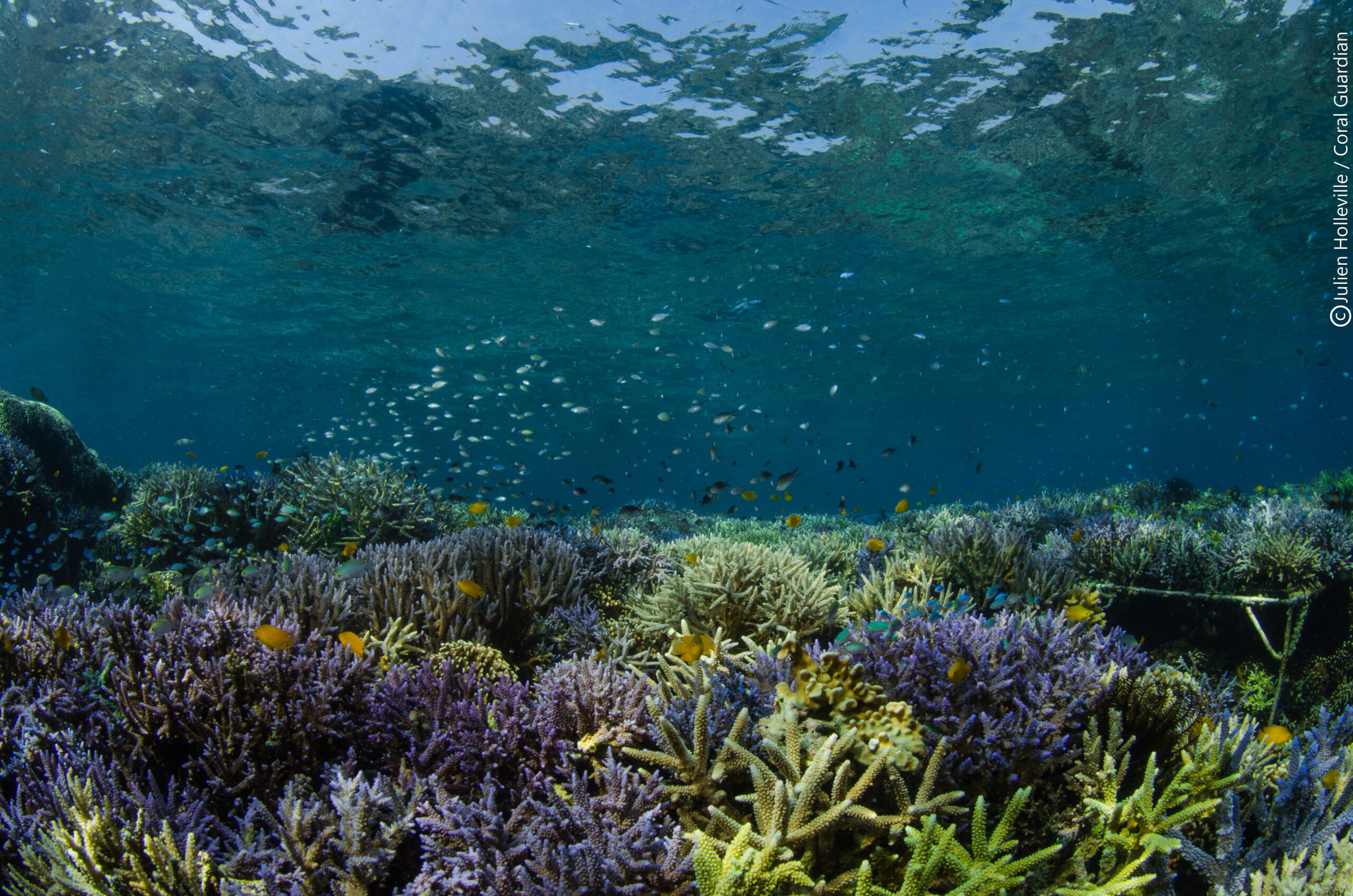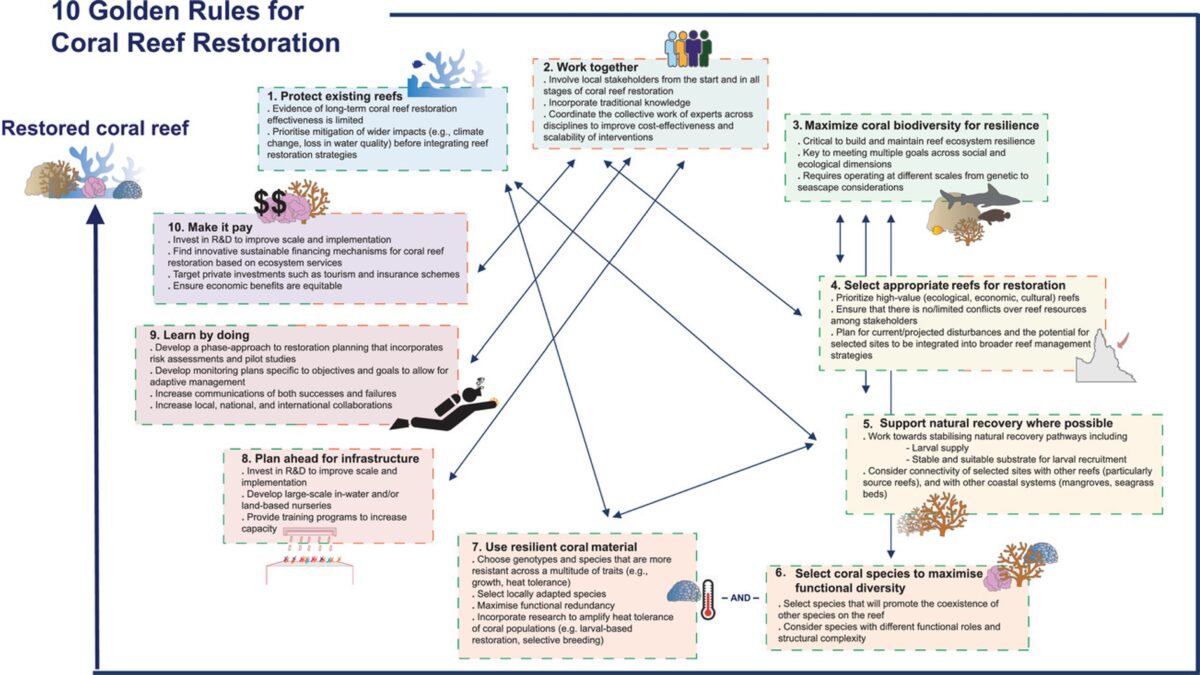The 10 golden rules of coral restoration

Special thanks to Margaux Hein, Kate M. Quigley and David J. Suggett.
Coral restoration is becoming more and more widespread throughout the world, often on a small scale. However, in order to have sustainable initiatives with convincing results (from a biological as well as a social and economic point of view), we need general principles that can be applied and adapted to different contexts. These 10 golden rules exist for terrestrial reforestation (DiSacco et al., 2021), but coral reefs are often compared to tropical forests, both in terms of biodiversity and functional complexity (Reaka-Kudla, 1996). The team of researchers, Dr Kate Quigley and colleagues, therefore undertook to transpose the 10 golden rules of reforestation to coral reef restoration, as published in the journal Conservation Biology. These 10 rules can be grouped under 3 main themes:
- protection of existing reefs
- the selection of corals and sites for restoration,
- the people involved and how they work together.

Figure 1: Ten rules for coral reef restoration, each fulfilling a functional objective. The order of the rules corresponds to the order in which the tasks should be considered when planning and implementing the project, although some are interdependent and should be considered in parallel. The colour of the outline of each box corresponds to functional objectives (green outlines: ecological rules; orange outlines: socio-economic rules).
- Protecting existing reefs (rules 1 “Protect existing reefs” and 5 “Support natural recovery where possible”).
Protecting coral reefs should always be the priority, even before restoration. This is because the scale at which reefs can be restored is very limited, while the impacts, particularly due to climate change, affect much larger areas. Putting in place effective protection programmes, especially against man-made threats, is critical.
Furthermore, when degradation reaches a certain threshold, there is a risk that the ecosystem will shift towards one dominated by algae or non-scleractinian corals, for example (Bell et al., 2021). Protecting a reef also allows it to recover more quickly from stress or to grow without human pressure (Mumby and Harborne, 2010). The absence of human intervention also avoids a necessarily artificial selection of restored corals (Quigley et al., 2022). Nevertheless, natural recovery can only occur if there are events of sexual reproduction on a stable substrate, which humans can possibly encourage but not trigger (dela Cruz and Harrison, 2020).
- Selection of corals and sites to be restored (rules 3. “Maximize coral biodiversity for resilience”, 4. “Select appropriate reefs for restoration”, 6 “Select coral species to maximise functional diversity”, 7 “Use resilient coral material”, 8 “Plan ahead for infrastructure”).
Restoring a reef requires a great deal of effort, particularly financial and human. The reefs to be restored must therefore be selected carefully, taking into account :
- their chances of survival in the face of future disturbances (global warming, meteorological disturbances such as storms, etc.),
- their connection with other reefs or ecosystems such as mangroves,
- their long-term interest for humans (fishing, tourism, etc.),
- their integration into wider protection schemes,
- the absence of conflicts with the reef (rule 2).
The choice of species to be restored must take account of local ecology. It is then necessary to select species with high growth rates and varied functional forms and roles. Guides for selecting these species are beginning to be published (Madin et al., 2021; Shaver et al., 2020).
Coral reef recovery is linked to the complexity of the substrate, i.e. the three-dimensionality of the seabed. The greater the structural complexity of the reef, the better the recovery following disturbance (Graham and Nash, 2013). The biodiversity of the reef must allow for a high level of structural complexity to create a refuge and habitat for many species. This requires a choice of different functional groups and different coral shapes, which provide shelter for a wide variety of organisms.
One technique for restoring coral reefs and increasing coral cover is to use fragments of living coral from cuttings or asexual propagation. To improve this proliferation, the use of nurseries is generally very effective (Stewart-Sinclair et al., 2021). On a large scale, this technique is expensive and risky in the long term, as there is little genetic diversity. Maintaining a high level of genetic diversity encourages sexual reproduction and increases the likelihood of obtaining larvae that are more resistant, particularly to heat. Various techniques exist to encourage sexual reproduction (e.g. Forsman et al., 2015; O’Neil et al., 2021), but they are not always easy to implement, as they involve significant financial costs, advanced technical knowledge and the need for suitable infrastructure.
- Collaborative working (rules 2 “Work together”, 9 “Learn by doing” and 10 “Make it pay”).
Each reef will have its own particularities to take into account, which means that even if guides exist, they must always be adapted locally (Hein et al., 2020; Shaver et al., 2020; Goergen et al., 2020). To achieve this, it is vital to involve the various local stakeholders and to encourage exchanges with international experts. In particular, this ensures that the design and implementation of the project take account of the reality on the ground, as well as the complementary knowledge of the stakeholders. The local communities are the guardians of the reef, which belongs to them. As such, they have traditional and ancestral knowledge that must be integrated into the protection and restoration process. In addition, the benefits can be distributed in a balanced way and any conflicts will be easier to manage. There are many examples of successful collaboration between associations and local people, such as Coral Guardian, Blue Ventures, etc.
Before embarking on a large-scale project, it is more effective to start small, carry out tests and adopt an iterative approach (pilot study, then change of scale, with long-term objectives and a schedule drawn up in advance). Taking things one step at a time, without trying to move too quickly, also helps to win the public’s trust (Quigley et al., 2022). For a project to be sustainable over time, it is important to have a constant supply of funding, often from the public, sponsors or local authorities.
Conclusion
Coral restoration is becoming increasingly widespread, but its effectiveness is not the same everywhere, and some reefs do not survive in the long term (Boström-Einarsson et al., 2020). Although still in its infancy, this approach to coral restoration can draw on decades of similar work, particularly in land-based reforestation. Applying these 10 golden rules, inspired by recommendations for terrestrial systems, and coordinating associations and governments on a larger scale, in particular, would perhaps enable coral reefs to be restored effectively and allow some of them to survive in a context of climate change.
Cited literature:
Quigley K.M., Hein M., Suggett D.J. 2022. Translating the 10 golden rules of reforestation for coral reef restoration. Conservation biology. 36(4), e13890.
Bell J.J., Micaroni V., Strano F., 2021. Regime shifts on tropical coral reef ecosystems: future trajectories to animal-dominated states in response to anthropogenic stressors. Emerg. Top. Life Sci. 6, 95-106.
Boström-Einarsson, L., Babcock, R.C., Bayraktarov, E., Ceccarelli, D., Cook, N., Ferse, S.C.A., Hancock, B., Harrison, P., Hein, M., Shaver, E., Smith, A., Suggett, D., Stewart-Sinclair, P.J., Vardi, T., McLeod, I.M., 2020. Coral restoration – A systematic review of current methods, successes, failures and future directions. PLOS ONE 15, e0226631.
dela Cruz D.W., Harrison P.L. 2020. Enhancing coral recruitment through assisted mass settlement of cultured coral larvae. PLoS ONE 15, e0242847.
DiSacco A., Hardwick K.A., Blakesley D., Brancalion P.H S., Breman E., Rebola L.C., Antonelli A. 2021. Ten golden rules for reforestation to optimise carbon sequestration, biodiversity recovery and livelihood benefits. Global ChangeBiology. 27(7), 1328-1348.
Forsman Z.H., Page C.A., Tooned R.J., Vaughan D. 2015. Growing coral larger and faster: Micro-colony-fusion as a strategy for accelerating coral cover. PeerJ. 3, e1313.
Goergen E., Schopmeyer S., Moulding A.L., Moura A., Kramer P., Viehman T.S. 2020. Coral reef restoration monitoring guide: Methods to evaluate restoration success from local to ecosystem scales. NOAA Technical Memorandum NOS NCCOS 279.
Graham N.A.J., Nash K.L. 2013. The importance of structural complexity in coral reef ecosystems. Coral Reefs 32, 315-326.
Hein, M. Y., McLeod, I. M., Shaver, E. C., Vardi, T., Pioch, S., BoströmEinarsson, L., Ahmed, M., & Grimsditch, G. 2020. Coral Reef Restoration as a strategy to improve ecosystem services –A guide to coral restoration methods. United Nations Environment Program.
Madin J.S., Madin E. 2015. The full extent of the global coral reef crisis. Conservation Biology, 29(6), 1724-1726.
Mumby P.J., Harborne A.R. 2010. Marine reserves enhance the recovery of corals on Caribbean reefs. PLOS ONE 5, e8657.
O’Neil K.L., Serafin R.M., Patterson J.T., Craggs J.R K. 2021. Repeated ex situ spawning in two highly disease susceptible corals in the family Meandrinidae. Frontiers in Marine Science. 8, 463.
Reaka-Kudla M.L. 1996. The global biodiversity of coral reefs: A comparison with rainforests, in: Biodiversity II: Understanding and Protecting Our Biological Resources. Joseph Henry Press.
Shaver E.C., Courtney C.A., West J.M., Maynard J., Hein M., Wagner C., …, Koss J. 2020. A manager’s guide to coral reef restoration planning and design. Technical Memorandum CRCP. Coral Reef Conservation Program, National Oceanic and Atmospheric Administration.
Stewart-Sinclair P.J., Klein C.J., Bateman I.J., Lovelock C.E. 2021. Spatial cost–benefit analysis of blue restoration and factors driving net benefits globally. Conservation Biology. 35(6), 1850-1860.
Ces articles pourraient vous intéresser

Do clouds support us in coral protection?
Mystery in the Pacific: who saved coral reefs at the Society Islands? Could the presence of clouds in the sky improve the health of coral…
28 November 2023Tracking ocean temperatures in situ and from space
Written by: Florina Jacob and Laura Bastide Why monitor water temperature in coral restoration zones? Coral health is closely linked to water temperature. The…
26 June 2023
Sponsor Spotlight : Zepp Health
Tell us a bit about yourself 🙂 At Zepp Health, we’re on a mission to empower people to take control of their well-being. We…
19 June 2023CALL FOR PROJECT PROPOSALS
For the development of a coral reef conservation programme in partnership with Coral Guardian. About Coral Guardian Coral Guardian is a French non-profit that was…
13 April 2023
